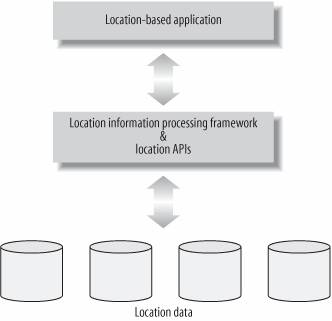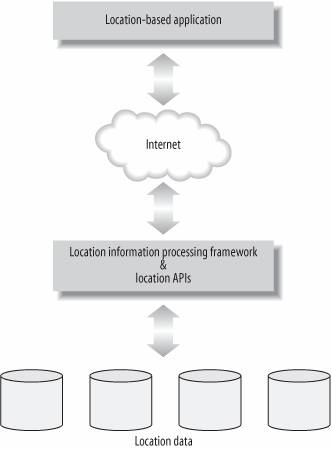Section 1.2. Location Application Architectures
1.2. Location Application ArchitecturesBeyond the application categories, you need to be aware of application architectures when building location-based applications. Location-based applications can be built using two different architectures:
Let's look at each of these categories in detail. 1.2.1. Disconnected Location-Based ApplicationsDisconnected location-based applications contain location information and related processing framework locally on the hosted computer hard disk, which means that network connectivity is not required for the application's functionality. A typical disconnected location-based application architecture is shown in Figure 1-1. The main advantage of this architecture is that the location data resides locally, so the applications can provide a faster and richer user experience; however, having data locally may also be viewed as a limitation for other reasons, such as the size of the application (since location data can easily grow to a few Gigabytes) and the data becoming out-of-date due to lack of frequent updates. The advantages include:
Figure 1-1. Disconnected location-based application architecture However, there are also disadvantages:
The decision to develop a disconnected location-based application should be based entirely on factors such as connectivity and functional richness of the application, which we will discuss in more detail later in this chapter. 1.2.2. Connected Location-Based ApplicationsConnected location-based applications contain location information and related processing framework on remotely located servers instead of the local hard disk, which means that a network connection is essential for the application to run. Typical connected-location based application architecture is shown in Figure 1-2. The main advantage of this architecture is that the location data and the related processing framework reside remotely, so the applications can be lightweight. Since the applications are loosely coupled to the location data, it is easy to update the data frequently to keep it up-to-date. The advantages of this architecture include:
Figure 1-2. Connected location-based application architecture However, there are still disadvantages:
Now that you have been introduced to location application categories and different architectures, let's see how Microsoft MapPoint technologies enable you to build both connected and disconnected location-based applications. |
EAN: 2147483647
Pages: 136